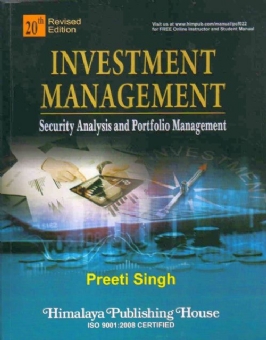Investment Management
no information available
Investment Management is a useful insight to the world of investment. In India, the interest in investment has become alive after 1991 when globalization and liberalization was set in as a part the economic reforms in India. Science stock markets have many intermediaries and processes of purchase and sale of securities, it is important that the money of the investors is safe and also brings a return in addition to their normal income. Many universities have introduced investment management as a subject to provide an understanding of various channels and sources and options in the investment world. The Indian Market is dynamic and changes take place in investment opportunities. There are many options available but the investor has to take wise decisions to gain money. This revised edition of the book has explained the return on securities and how single and combination of securities provide returns. Investment management extends beyond the Indian boundaries as investments now in different countries. ADRs, GDRs., debt financing and loan syndication all extend to investment in different countries. This book has been written to provide information to students and teachers in India on various kinds of securities that are available. It also explains theories and practical aspects of investing in different countries. The book has been written in a very simple style to reach out to students. It explains the concepts with the illustrations and examples. It has explanations and gives the latest developments in Indian Stock Markets. It also gives the function and guidelines of Securities Exchange Board of India which is the market regulator. The following are some of its salient features: - It explains the concepts of investment, speculation and gambling. - It gives the process of investment and the importance of review and change of the various securities owned by an investor if they are not profitable. - It is an insight into the risks and return on an investment and on the combination of more than one security. - It discusses the complementary nature of the new issue market and stock market. - It explains the role and responsibilities and mechanics of trading in a stock market. - It illustrates valuations of equity shares and bonds. - It has given the basic explanation of derivatives with examples of futures and options. - The theories of Fundamental analysis, Technician Market are discussed in detail. - The importance of CAPM Model for pricing of securities has been explained. - The portfolio management techniques, selection and diversification through Markowitz and Sharpe's Models and Arbitrage Pricing Theory are given. - The differences between Capital Market Line and Security Market Line are provided. - Comparison between managed mutual funds and other investment has been explained. Contents : 1. Investment Management – An Introduction 2. Indian Securities Market 3. Securities Exchange Board of India 4. Risk 5. Returns 6. The Investment Alternatives (Bonds, Preference Shares and Equity Shares and Derivatives) 7. Derivatives 8. Security Valuation 9. Alternative Forms of Investment 10. Dividend Policies and the Investor 11. Investor and Interest Rates 12. Fundamental Analysis 13. Technical Analysis 14. Efficient Market Theory 15. Portfolio Analysis 16. Portfolio Selection and International Diversification 17. Techniques of Portfolio Revision 18. Performances Measurements of Managed Portfolios (Mutual Funds) Glossary Appendices ... Read more Read less











